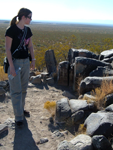Fee Free Days for National Parks

No time or money in the budget for field trips? Encourage your students to visit historic sites on their own. High school teacher James A. Percoco has incorporated "Individual Field Trips" (IFT) into his teaching for more than two decades. Each IFT requires students to visit a historic site or exhibit related to what they are learning in the classroom and to record and share their experiences. When students study the American Revolution and George Washington, they visit Mount Vernon. When they study the wars of the 20th century, they visit the war memorials on the National Mall in Washington, DC. These visits help students understand history as a living force, physically present in their communities and constantly being interpreted and reinterpreted.
Think you're too far away from major historic sites for IFTs to benefit your students? Students can benefit as much from exploring local history as they can from exploring national and state history! Turn to local museums, libraries, and historical associations with suggestions from Teachinghistory.org's Daisy Martin.
If you have national parks and historic sites near you, take advantage of their Fee Free Days. According to the National Park Service (NPS), 264 of its more than 390 parks don't charge admission fees, but don't be intimidated if the NPS sites you'd most like your students to visit do charge fees. Plan ITF assignments so that students have the option to visit sites on one of several days every year that all NPS locations waive visitor fees.
Want your students to visit a museum? Consider planning your IFT around Smithsonian Magazine's Museum Day Live! On September 29, admission to any participating museum is free if students print out and bring along a downloadable ticket.
Whichever sites you choose for your students, make certain to visit the places yourself first. As you explore a site, consider what you want your students to see and how you want them to see it. What connections do you hope they'll make? What aspects of the place might they overlook without guidance? By visiting the site ahead of time, you can plan pre- and post-visit materials and activities that make your students' IFT experience more than just a day out.